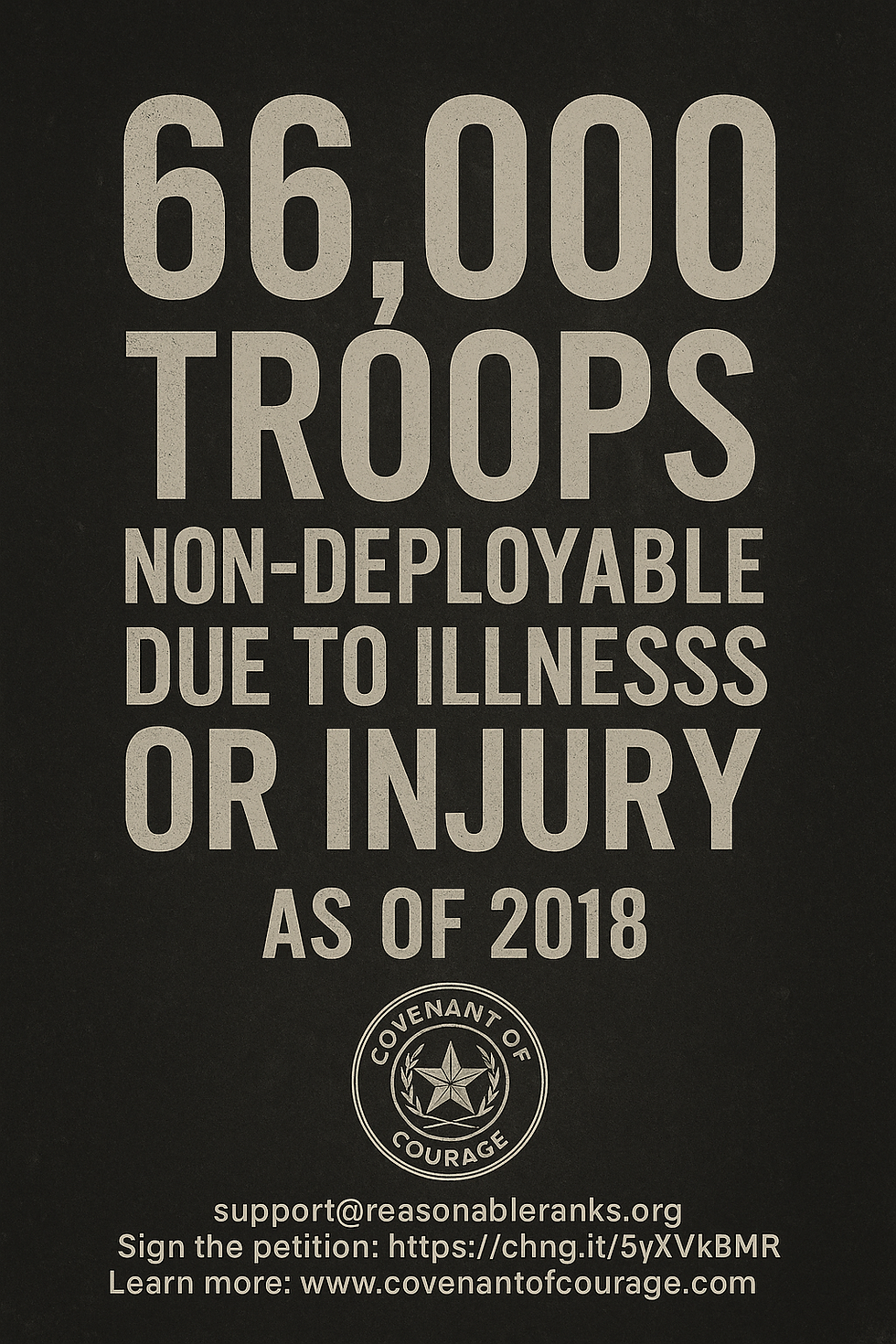66,000 Troops Non-Deployable Due to Illness or Injury as of 2018: A Wake-Up Call for Reform
- Kirk Carlson
- Jul 25
- 2 min read

In 2018, the Department of Defense (DoD) disclosed a staggering statistic: approximately 66,000 active-duty service members were classified as non-deployable due to illness, injury, or medical limitation. That number represented about 13–14% of the total force at the time, underscoring a critical vulnerability within our military readiness and an urgent need to reevaluate how we manage, retain, and support injured personnel.
📊 Understanding the Numbers
The term “non-deployable” refers to service members who, for medical, legal, or administrative reasons, cannot be sent to operational theaters. According to then-Defense Secretary James Mattis, readiness and lethality were being compromised by the accumulation of non-deployable troops, prompting a push for more stringent standards and timelines to return personnel to deployable status—or process them for administrative discharge.
But while the policy sought to preserve combat readiness, it also raised ethical, legal, and logistical concerns, especially when dealing with those who were injured in the line of duty.
💔 The Hidden Toll on Injured Warriors
For many of the 66,000 troops, non-deployable status wasn’t due to negligence or avoidance—but because they had sustained life-altering injuries in service, often while deployed. These injuries include:
Musculoskeletal damage from combat and training
Traumatic Brain Injury (TBI)
Post-Traumatic Stress Disorder (PTSD)
Chronic illnesses from toxic exposures (burn pits, chemicals, etc.)
Permanent damage from overuse or neglect during duty
These service members were now being faced with involuntary separation or Medical Evaluation Board (MEB) proceedings simply because they could no longer meet physical requirements—despite their proven record, willingness to serve, and years of sacrifice.
🧩 The Bigger Problem: No Path for Reassignment
One of the core failures highlighted by this crisis was the lack of a formal reassignment pathway for those who still wanted to serve in meaningful ways, but could no longer deploy. While civilian sectors thrive on workforce adaptability, the military remains largely rigid—often labeling personnel “unfit” instead of exploring alternative roles that match their experience and capabilities.
This means we’re discarding leadership, talent, and institutional knowledge—while simultaneously struggling with recruitment shortfalls.
⚖️ What This Means for Reform
The issue is more than operational. It’s a moral imperative.
These 66,000 non-deployable troops represent the tip of an iceberg. Without comprehensive reform, we risk:
Increasing homelessness and suicide among injured veterans
Worsening public trust in military service outcomes
Losing skilled professionals who could serve in logistics, cybersecurity, training, or mentorship roles
Creating a generation of veterans who feel discarded by the institution they once pledged to defend
💡 Covenant of Courage & #ReasonableRanks
This is why Covenant of Courage launched the #ReasonableRanks campaign—to advocate for discharge policy reform, reassignment pathways, and community-based roles for injured service members who still want to contribute. We believe that disability should not equal disposability.
As of today, thousands of supporters have signed our petition, and city governments across California have begun issuing letters of support. But we need national attention and Congressional action to drive lasting change.
📣 Join the Movement
If you believe that no warrior should be discarded for being wounded—if you believe that strength comes not just from combat, but from character, resilience, and the will to serve—then stand with us.
🖊 Sign the petition: https://chng.it/5yXYvkBtMR
🌐 Learn more: www.covenantofcourage.com





Comments